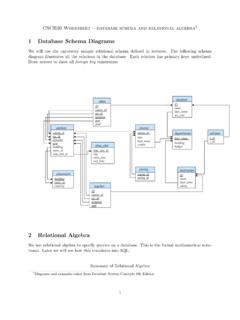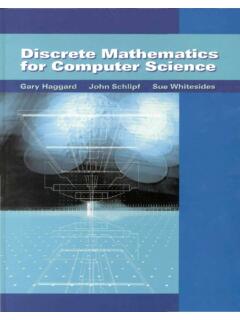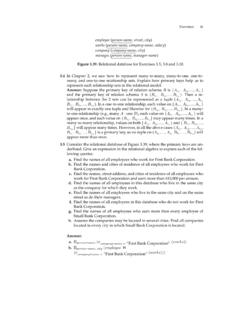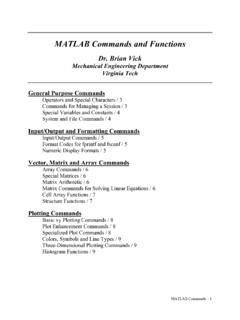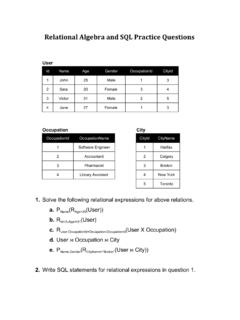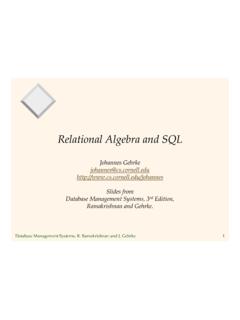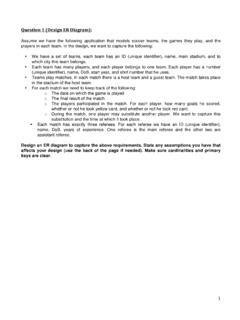Transcription of Eigen Tutorial - GitHub Pages
1 Eigen TutorialCS2240 Interactive Computer GraphicsCS2240 Interactive Computer GraphicsIntroductionEigen is an open-source linear algebra library implemented in C++. It s fast and well-suited for awide range of tasks, from heavy numerical computation, to simple vector arithmetic. The goal ofthis Tutorial is to introduce the features of Eigen required for implementing graphics applications,to readers possessing basic knowledge of C++, linear algebra , and computer reading this Tutorial , the reader should be able to1. Install Eigen on computers running Linux, Mac OS, and Create and initialize matrices and vectors of any size with Eigen in C++.
2 3. Use Eigen for basic algebraic operations on matrices and vectors. The reader should beable to perform addition, multiplication, scalar multiplication, and matrix inversion Use Eigen s built-in functions to create 4x4 transformation EigenWe ll use Git to download the source files for Eigen into the user s home directory. You can, ofcourse, use any directory you prefer - just replace the tilde~in the following commands withyour desired download path.$ cd ~$ git clone https:// -git -mirrorIf you re like me and the idea of building libraries from source gives you the jitters, don t worry- we don t need to build anything here.
3 Eigen usespure header libraries, which means all itssource code is included in header files. There are no for function and classdefinitions - everything goes into This makes using Eigen quite simple. To beginusing it, simply#includethese header files at the beginning of your own code. You can findthese headers in~/ Eigen -git-mirror/ course, the compiler needs to be told the location on disk of any header files you can copy the~/ Eigen -git-mirror/Eigenfolder to each new project s directory. Or, youcould add the folder once to the compiler s default include path. You can do this by runningthe following command on machines with Linux or Mac OS:$ sudo ln -s /usr/local/include ~/ Eigen -git -mirror/EigenIf you re using a lab machine, add the following line to the end of~/.
4 Bashprofileexport CPLUS_INCLUDE_PATH=$CPLUS_INCLUDE_PATH$ :~/ Eigen -git -mirrorIf you re using QTCreator, add the following line to your project (.PROJ) file:QMAKE_CXXFLAGS = -I "~/ Eigen -git -mirror"2 Eigen TutorialGood day, Universe!Let s test our installation by writing a simple program. If you ve followed the steps above, youshould be able to compile the following piece of code without any additional configuration.#include < Eigen /Core >#include <iostream >using namespace std;using namespace Eigen ;int main() {cout << " Eigen version: " << EIGEN_MAJOR_VERSION << "."<< EIGEN_MINOR_VERSION << endl;return 0;}MatricesCreating matrices with Eigen is simple:Matrix3f A;Matrix4d B; Eigen uses a naming convention for its datatypes that is quite similar to OpenGL.
5 The actualdatatype name is followed by suffixes that describe its size, and the type of its member elementsrespectively. In the example above, the variableAis of typeMatrix3f that is, a 3x3 matrixof floats. The variableBis a 4x4 matrix of doubles. Keep in mind, though, that not allcombinations of size and type are valid Matrix2iworks, butMatrix5sthrows an is not to say you can t create 5x5 matrices of typeshort, or that you can only createsquare matrices. Doing so merely requires a slightly different syntax:// 5x5 matrix of type shortMatrix <short , 5, 5> M1;// 20x75 matrix of type floatMatrix <float , 20, 75> M2;In fact, this is howallmatrices in Eigen are created under the hood.
6 The datatype namesdescribed above are only provided as a convenience for commonly used sizes and types. What smore, Eigen even allows us to create matrices whose size is not known at compile time by usinganXin place of the size suffix (MatrixXf,MatrixXd).However, as the majority of graphics operations only require us to work with 3x3 and 4x4 singleor double precision matrices, we will restrict our attention in this Tutorial to the datatypesMatrix3f,Matrix4f,Matrix3d, Interactive Computer GraphicsInitializationNow that we ve created our matrix variables, let s assign some values to them:// Initialize AA << , , , , , , , , ;// Initialize B by accessing individual elementsfor i = 1:4 {for j = 1:4 {B(j, i) = ;}}The first method shown above uses the comma initializer syntax: the programmer specifiesthe coefficientsrow by row.
7 Note that all coefficients need to be provided if the number ofcoefficients does not match the size of the matrix, the compiler will throw an error. Thus, youcan imagine this syntax becoming quite cumbersome for large second method accesses the individual coefficients of the matrix B using the overloadedparantheses operators. Indexing starts at zero, with the first index specifying the row number,and the second the column number. As you have probably guessed, you can use the same syntaxto query the coefficients. Can you guess whether the following code prints a zero or a one?cout << A(1, 2);Notice that we have structured our loops such that the outer loop runs over the columns, andthe inner loop iterates over the rows.
8 Doing it the other way around would have worked too,but would have been less efficient. This is because Eigen stores matrices incolumn-major orderby default. This can be a bit confusing since coefficients in the comma initialization format arespecified in row-major order. Another potential point of confusion is that unlike C/C++, orPython arrays, Eigen uses parantheses rather than square brackets to access matrix addition to the above two methods, Eigen provides utility functions to initialize matrices topredefined values:// Set each coefficient to a uniform random value in the range[-1, 1]A = Matrix3f :: Random ();// Set B to the identity matrixB = Matrix4d :: Identity ();// Set all elements to zeroA = Matrix3f ::Zero();// Set all elements to onesA = Matrix3f ::Ones();1 When using comma initialization, the inputs can even be other matrices and vectors.
9 You can learn moreabout this feature Tutorial // Set all elements to a constant valueB = Matrix4d :: Constant ( );Matrix OperationsCommon arithmetic operators are overloaded to work with matrices:Matrix4f M1 = Matrix4f :: Random ();Matrix4f M2 = Matrix4f :: Constant ( );// Addition// The size and the coefficient -types of the matrices must matchcout << M1 + M2 << endl;// Matrix multiplication// The inner dimensions and the coefficient -types must matchcout << M1 * M2 << endl;// Scalar multiplication , and subtraction// What do you expect the output to be?cout << M2 - Matrix4f ::Ones() * << endl;Equality (==) and inequality (!)
10 =) are the only relational operators that work with matrices are considered equal if all corresponding coefficients are << (M2 - Matrix4f ::Ones() * == Matrix4f ::Zero())<< endl;Common matrix operations are provided as methods of the matrix class:// Transpositioncout << () << endl;// Inversion ( #include < Eigen /Dense > )// Generates NaNs if the matrix is not invertiblecout << () << endl;Sometimes, we may prefer to apply an operation to a matrix element-wise. This can be doneby asking Eigen to treat the matrix as a general array by invoking thearray()method:// Square each element of the matrixcout << ().

